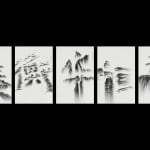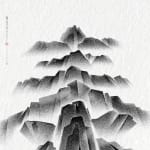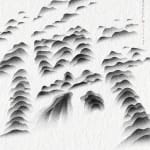







The Five Great Mountains of China
Further images
-
(View a larger image of thumbnail 1
)

-
(View a larger image of thumbnail 2
)

-
(View a larger image of thumbnail 3
)

-
(View a larger image of thumbnail 4
)

-
(View a larger image of thumbnail 5
)

-
(View a larger image of thumbnail 6
)

-
(View a larger image of thumbnail 7
)

-
(View a larger image of thumbnail 8
)

-
(View a larger image of thumbnail 9
)


Moving Mountains
Chinese civilisation is rooted in the physical geography and natural history that have conditioned and shaped how a people make sense of their surroundings. The mountains’ majesty is inspiring and beckoning as well as humbling and daunting, so it is hardly surprising that legends, folklore, religious cannons, and fine works of literature give the five great mountains deep meaning, and a dimension where the Chinese people express their thoughts. In this series of monochromatic posters for the Caobu Public Library in Guangdong Province, the mountain faces and ridge lines become fur brush stokes that compose the Chinese character of each of the five mountains’ names: Tai, Hua, Song, and two different Mount Hengs one in the west and the other in the north. Each character has a geomorphic ring, so Mount Tai seems to sit against a white background, Mount Hua stands still, Mount Song lies on an open plain, represented by blank space, and the western Mount Heng seems to be flying, while the northern one walks slowly. The custom typography shows the beauty of Chinese calligraphy as well as the power of ideograms in the written word.

